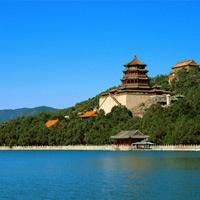 The Beijing Summer Palace (Yiheyuan) is an immense park containing some newish Qing architecture. The site had long been a royal garden and it was considerably enlarged and embellished by Emperor Qianlong in the 18th century. He deepened and expanded Kunming Lake with the help of 100,000 laborers - and reputedly surveyed Imperial Navy drills from a hilltop perch. In 1860 Anglo-French troops gutted and looted the place during the Opium War. Empress Dowager Cixi began rebuilding in 1888 using money that was supposedly reserved for the construction of a modern navy- but she did restore a marble boat that sits immobile at the edge of the lake. She had this ugly thing fitted out with several large mirrors and used to dine at the lakeside. In 1900 foreign troops, annoyed by the Boxer Rebellion, had another go at roasting the Summer Palace- restorations took place a few years later, and a major renovation occurred after 1949 (by which time the palace had once more fallen into disrepair).
The Beijing Summer Palace (Yiheyuan) is an immense park containing some newish Qing architecture. The site had long been a royal garden and it was considerably enlarged and embellished by Emperor Qianlong in the 18th century. He deepened and expanded Kunming Lake with the help of 100,000 laborers - and reputedly surveyed Imperial Navy drills from a hilltop perch. In 1860 Anglo-French troops gutted and looted the place during the Opium War. Empress Dowager Cixi began rebuilding in 1888 using money that was supposedly reserved for the construction of a modern navy- but she did restore a marble boat that sits immobile at the edge of the lake. She had this ugly thing fitted out with several large mirrors and used to dine at the lakeside. In 1900 foreign troops, annoyed by the Boxer Rebellion, had another go at roasting the Summer Palace- restorations took place a few years later, and a major renovation occurred after 1949 (by which time the palace had once more fallen into disrepair).
The original palace was used as a summer residence, an escape from the ferocious heat. The Forbidden City packed up and decamped here for their holidays, so the emphasis is on cool features- water, gardens, etc. It was divided into four sections - court reception, residences, temples and strolling or sightseeing areas.
Three-quarters of the park is occupied by Lake Kunming, and most items of structural interest are located toward the east gate or the north gate. The main building is the Hall of Benevolence and Longevity, just off the lake toward the east gate. It houses a hardwood throne, and has a courtyard with bronze animals; it was used by the emperor-in-residence for handling state affairs and receiving envoys.
Along the north shore of the lake is decorated with mythical scenes - if the paint looks new it's because a lot of pictures were whitewashed during the Cultural Revolution.
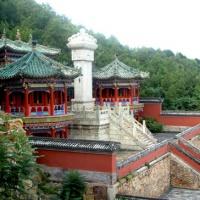
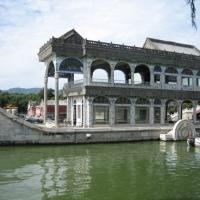
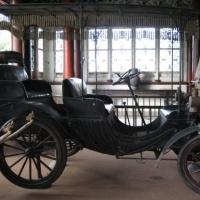
On made-made Longevity Hill are a number of temples. The Pavilion of Precious Clouds is on the western slopes and is one of the few structures to escape destruction by the Anglo-French forces. It contains some elaborate bronzes. At the top ot the hill sits the Buddhist Temple of the Sea of Wisdom, made of glazed tiles: good views of the lake can be had from this spot.
Other buildings are largely associated with Empress Cixi like the place where she kept Emperor Guangxu under house arrest, the place where she celebrated her birthdays, and exhibitions of her furniture and memorabilia. It's a very Disneylandish atmosphere that pervades this "museum"; tourists can have their photos taken, imperial dressed-up fashion, down by the lakeside just east of the marble boat.
In the same vicinity is the Tingliguan Restaurant serving banquet imperial food on regal tableware look-alikes (fish from Lake Kunming, velvet chicken, dumplings). Splendid al fresco location, exorbitant prices, housed in what was once an imperial theatre, and has souvenir shops attached.
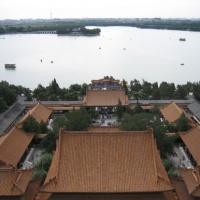 Other noteworthy features of the Summer Palace are the seventeen arch bridge spanning 150 meters to South Lake Island - on the mainland side is a beautiful bronze ox; the Jade Belt Bridge down the mid-west side of the lake; and the Garden of Harmonious Interest at the north-east end (a copy of Wuxi garden). You can get around the lake to the bridges by rowboat: boating and swimming are popular pastimes for the locals (windsurfing for the richer) - in winter it's skating. As with the Forbidden City Moat, slabs of ice are cut out of the lake in winter and stored for summer use.
Other noteworthy features of the Summer Palace are the seventeen arch bridge spanning 150 meters to South Lake Island - on the mainland side is a beautiful bronze ox; the Jade Belt Bridge down the mid-west side of the lake; and the Garden of Harmonious Interest at the north-east end (a copy of Wuxi garden). You can get around the lake to the bridges by rowboat: boating and swimming are popular pastimes for the locals (windsurfing for the richer) - in winter it's skating. As with the Forbidden City Moat, slabs of ice are cut out of the lake in winter and stored for summer use.
The park is about 12 km north-west of the center of Beijing. If you consult a bus map, you'll see the Beijing- Miyun Irrigation Canal feeding from Yuyuan Lake to Kunming Lake- good route for biking because the bus map will show which side of various sections of the canal is bikeable.
